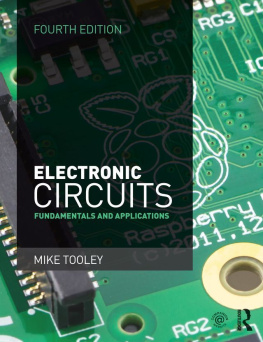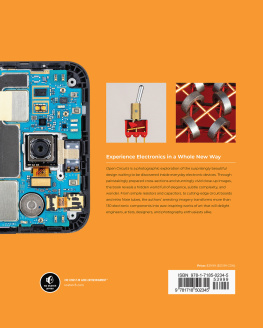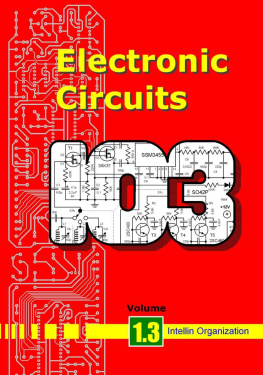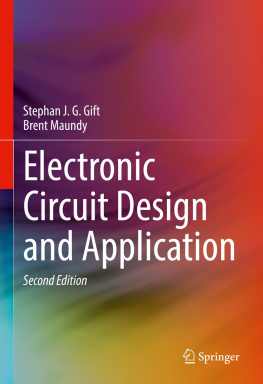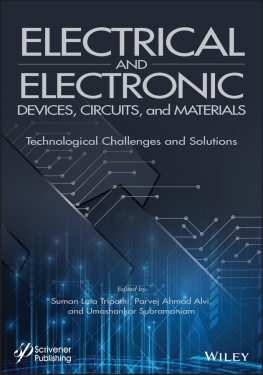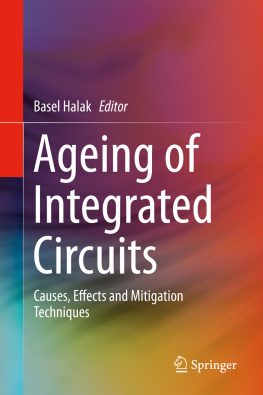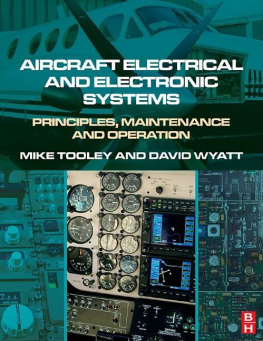Tooley - Electronic Circuits
Here you can read online Tooley - Electronic Circuits full text of the book (entire story) in english for free. Download pdf and epub, get meaning, cover and reviews about this ebook. year: 2015, publisher: Taylor and Francis, genre: Romance novel. Description of the work, (preface) as well as reviews are available. Best literature library LitArk.com created for fans of good reading and offers a wide selection of genres:
Romance novel
Science fiction
Adventure
Detective
Science
History
Home and family
Prose
Art
Politics
Computer
Non-fiction
Religion
Business
Children
Humor
Choose a favorite category and find really read worthwhile books. Enjoy immersion in the world of imagination, feel the emotions of the characters or learn something new for yourself, make an fascinating discovery.
- Book:Electronic Circuits
- Author:
- Publisher:Taylor and Francis
- Genre:
- Year:2015
- Rating:4 / 5
- Favourites:Add to favourites
- Your mark:
- 80
- 1
- 2
- 3
- 4
- 5
Electronic Circuits: summary, description and annotation
We offer to read an annotation, description, summary or preface (depends on what the author of the book "Electronic Circuits" wrote himself). If you haven't found the necessary information about the book — write in the comments, we will try to find it.
Electronic Circuits — read online for free the complete book (whole text) full work
Below is the text of the book, divided by pages. System saving the place of the last page read, allows you to conveniently read the book "Electronic Circuits" online for free, without having to search again every time where you left off. Put a bookmark, and you can go to the page where you finished reading at any time.
Font size:
Interval:
Bookmark:
Electronics explained in one volume, using both theoretical and practical applications.
- New chapter on Raspberry Pi
- Companion website contains free electronic tools to aid learning for students and a question bank for lecturers
- Practical investigations and questions within each chapter help reinforce learning
Mike Tooley provides all the information required to get to grips with the fundamentals of electronics, detailing the underpinning knowledge necessary to appreciate the operation of a wide range of electronic circuits, including amplifiers, logic circuits, power supplies and oscillators. The fourth edition now offers an even more extensive range of topics, with extended coverage of practical areas such as Raspberry Pi.
The books content is matched to the latest pre-degree level courses (from Level 2 up to, and including, Foundation Degree and HND), making this an invaluable reference text for all study levels, and its broad coverage is combined with practical case studies based in real-world engineering contexts. In addition, each chapter includes a practical investigation designed to reinforce learning and provide a basis for further practical work.
A new companion website at www.key2electronics.com offers the reader a set of spreadsheet design tools that can be used to simplify circuit calculations, as well as circuit models and templates that will enable virtual simulation of circuits in the book. These are accompanied by online self-test multiple choice questions for each chapter with automatic marking, to enable students to continually monitor their own progress and understanding. A bank of online questions for lecturers to set as assignments is also available.
Mike Tooley has over 30 years experience of teaching electrical principles, electronics and avionics to engineers and technicians, previously as Head of Department of Engineering and Vice Principal at Brooklands College in Surrey, UK, and currently works as a consultant and freelance technical author.
Fundamentals and applications
Fourth edition
Mike Tooley

Fourth edition published 2015
by Routledge
2 Park Square, Milton Park, Abingdon, Oxon OX14 4RN
and by Routledge
711 Third Avenue, New York, NY 10017
Routledge is an imprint of the Taylor & Francis Group, an informa business
2015 Mike Tooley
The right of Mike Tooley to be identified as author of this work has been asserted by him in accordance with sections 77 and 78 of the Copyright, Designs and Patents Act 1988.
All rights reserved. No part of this book may be reprinted or reproduced or utilised in any form or by any electronic, mechanical, or other means, now known or hereafter invented, including photocopying and recording, or in any information storage or retrieval system, without permission in writing from the publishers.
Trademark notice: Product or corporate names may be trademarks or registered trademarks, and are used only for identification and explanation without intent to infringe.
First edition published by Elsevier 1995 as Electronic Circuits Student Handbook
Third edition published by Elsevier 2006
British Library Cataloguing-in-Publication Data
A catalogue record for this book is available from the British Library
Library of Congress Cataloging in Publication Data
Tooley, Michael H.
Electronic circuits: fundamentals and applications / Mike Tooley.
pages cm
"First published by Elsevier 2006"Verso title page.
Includes index.
ISBN 978-1-138-82892-6 (pbk.: alk. paper) ISBN 978-1-315-73798-0 (ebook)
1. Electronic circuits. I. Title.
TK7867.T6583 2015
621.3815dc23
2014036001
ISBN: 978-1-138-82892-6 (pbk)
ISBN: 978-1-315-73798-0 (ebk)
Typeset in Univers by
Servis Filmsetting Ltd, Stockport, Cheshire
| Note that there is an additional chapter and extra resources on the companion website for this title. |
| Visit www.key2electronics.com for more information. |
This is the book that I wish I had when I first started exploring electronics over half a century ago. In those days, transistors were only just making their debut and integrated circuits were completely unknown. Of course, since then much has changed but, despite all of the changes, the world of electronics remains a fascinating one. And, unlike most other advanced technological disciplines, electronics is still something that you can do at home with limited resources and with a minimal outlay. A soldering iron, a multi-meter and a handful of components are all you need to get started. Except, of course, for some ideas to get you started and thats exactly where this book comes in!
The book has been designed to help you understand how electronic circuits work. It will provide you with the basic underpinning knowledge necessary to appreciate the operation of a wide range of electronic circuits, including amplifiers, logic circuits, power supplies and oscillators.
The book is ideal for people who are studying electronics for the first time at any level, including a wide range of school and college courses. It is equally well suited to those who may be returning to study or who may be studying independently as well as those who may need a quick refresher. The book has 19 chapters, each dealing with a particular topic, and ten appendices containing useful information. The approach is topic-based rather than syllabus-based and each major topic looks at a particular application of electronics. The relevant theory is introduced on a progressive basis and delivered in manageable chunks.
In order to give you an appreciation of the solution of simple numerical problems related to the operation of basic circuits, worked examples have been liberally included within the text. In addition, a number of problems can be found at the end of each chapter and solutions are provided at the end of the book. You can use these end-of-chapter problems to check your understanding and also to give you some experience of the short answer questions used in most in-course assessments. For good measure, we have included 80 revision problems in .
At the end of the book you will find 22 sample coursework assignments. These should give you plenty of food for thought as well as offering you some scope for further experimentation. It is not envisaged that you should complete all of these assignments, and a carefully chosen selection will normally suffice. If you are following a formal course, your teacher or lecturer will explain how these should be tackled and how they can contribute to your course assessment.
While the book assumes no previous knowledge of electronics, you need to be able to manipulate basic formulae and understand some simple trigonometry in order to follow the numerical examples. A study of mathematics to GCSE level (or equivalent) will normally be adequate to satisfy this requirement. However, for those who may need a refresher or have had previous problems with mathematics, will provide you with the underpinning mathematical knowledge required.
In the later chapters of the book, a number of representative circuits (with component values) have been included together with sufficient information to allow you to adapt and modify the circuits for your own use. These circuits can be used to form the basis of your own practical investigations or they can be combined together in more complex circuits.
This latest edition brings the book up to date with coverage of several important new topics, including the use of digital storage and sound card oscilloscopes, HDL/VHDL modelling of large-scale logic systems and a completely new chapter devoted to the Raspberry Pi.
Font size:
Interval:
Bookmark:
Similar books «Electronic Circuits»
Look at similar books to Electronic Circuits. We have selected literature similar in name and meaning in the hope of providing readers with more options to find new, interesting, not yet read works.
Discussion, reviews of the book Electronic Circuits and just readers' own opinions. Leave your comments, write what you think about the work, its meaning or the main characters. Specify what exactly you liked and what you didn't like, and why you think so.

